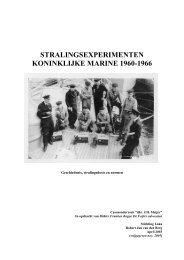Nuclear power plant ageing and life extension: Safety ... - Laka.org
Nuclear power plant ageing and life extension: Safety ... - Laka.org
Nuclear power plant ageing and life extension: Safety ... - Laka.org
Create successful ePaper yourself
Turn your PDF publications into a flip-book with our unique Google optimized e-Paper software.
<strong>Nuclear</strong> <strong>power</strong> & safety<strong>Nuclear</strong> <strong>power</strong> <strong>plant</strong> <strong>ageing</strong><strong>and</strong> <strong>life</strong> <strong>extension</strong>:<strong>Safety</strong> aspectsAn overview of issues <strong>and</strong> the IAEA's symposiumby Stanislav Novak <strong>and</strong> Milan PodestExperience with large fossil-fired electrical generatingunits, as well as in all process industries, shows that<strong>plant</strong>s begin to deteriorate with age after approximately10 years of operation. Similar phenomena will prevailfor nuclear <strong>plant</strong>s, <strong>and</strong> it is reasonable to postulate thattheir availability will be affected, as will their safety, ifappropriate measures are not taken.It is evident that the average age of <strong>power</strong> reactors inthe IAEA's Member States is increasing. (See accompanyinggraphs.) By 2000, more than 50 nuclear <strong>plant</strong>swill have been providing electricity for 25 years orlonger. Most nuclear <strong>power</strong> <strong>plant</strong>s have operating <strong>life</strong>timesof between 20 <strong>and</strong> 40 years.Ageing is defined as a continuing time-dependentdegradation of material due to service conditions,including normal operation <strong>and</strong> transient conditions. It iscommon experience that over long periods of time, thereis a gradual change in the properties of materials. Thesechanges can affect the capability of engineered components,systems, or structures to perform their requiredfunction. Not all changes are deleterious, but it is commonlyobserved that <strong>ageing</strong> processes normally involvea gradual reduction in performance capability.All materials in a nuclear <strong>power</strong> <strong>plant</strong> can suffer from<strong>ageing</strong> <strong>and</strong> can partially or totally lose their designedfunction. Ageing is not only of concern for active components(for which the probability of malfunctionincreases with time) but also for passive ones, since thesafety margin is being reduced towards the lowest allowablelevel.Effects of <strong>plant</strong> <strong>ageing</strong>The main <strong>ageing</strong> effects of concern are changes inphysical properties (e.g., electric conductivity); irradiationembrittlement; thermal embrittlement; creep;fatigue; corrosion (including erosion <strong>and</strong> crackingassisted by corrosion); wear (e.g., fretting <strong>and</strong> crackingassisted by wear, such as fretting fatigue).The term "<strong>ageing</strong>" thus represents the cumulativechanges over time that may occur within a component orMessrs. Novak <strong>and</strong> Podest are staff members in the Department of<strong>Nuclear</strong> Power <strong>and</strong> <strong>Safety</strong>.structure because of one or more of these factors. Fromthis perspective, it is clear that this is a complex processthat begins as soon as a component or structure isproduced <strong>and</strong> continues throughout its service <strong>life</strong>.Age distribution of nuclear <strong>power</strong> <strong>plant</strong>s0 5 10 15 20 25 30 35Years of operationProjected numbers of nuclear <strong>power</strong> reactorsreaching 30 years of operation 1990-2000.7060» 50I 40O| 30z20101II1I I Ii1990 91 92 93 94 95 96 97 98 99 2000Year-{Source: IAEA Power Reactor Information System.)IAEA BULLETIN, 4/1987 31
<strong>Nuclear</strong> <strong>power</strong> & safetyAgeing is certainly a significant factor in determiningthe limits of nuclear <strong>plant</strong> <strong>life</strong>time or <strong>life</strong> <strong>extension</strong>s. Nonuclear <strong>plant</strong>, including those still under construction orbeing mothballed, should be considered immune from itseffects.The rate of <strong>ageing</strong> depends strongly on both theservice conditions <strong>and</strong> the material sensitivity to thoseconditions. Therefore, consideration about <strong>ageing</strong> muststart in the design phase by selecting adequate materials<strong>and</strong> it should be continued throughout its complete <strong>life</strong>cycle.Although nuclear <strong>plant</strong> <strong>ageing</strong> could have an impacton the efficiency of electric <strong>power</strong> generation, safetycould be affected as well — if degradation of key componentsor structures is not detected before loss of functionalcapability, <strong>and</strong> if timely corrective action is nottaken. What must be understood is how the <strong>ageing</strong>process may change the likelihood of component failures(<strong>and</strong> therefore reduce safety margins), <strong>and</strong> how agedegradation can cause such events to be initiated.Concerns about <strong>ageing</strong> of equipment stem from thefact that failure can occur simultaneously (or effectivelyso) in redundant safety systems. Redundancy (coupledwith diversity) is the principal means of guarding againstthe consequences of r<strong>and</strong>om failures of equipment <strong>and</strong>providing assurance that at least one complete chain ofsafety systems is functional at all times during <strong>plant</strong>operation. The required protection would not beprovided if equipment <strong>ageing</strong> degrades the functionalcapability to the point where the increase in stress levelsassociated with a design basis event could cause simultaneousfailure of redundant systems (or their failurewithin a critical interval of time).Monitoring <strong>and</strong> detectionOperating <strong>org</strong>anizations have been using differentprogrammes or methods to prevent, detect, correct, <strong>and</strong>mitigate failures of systems <strong>and</strong> components from anycause including the effects of <strong>ageing</strong> degradation. Thesemethods include preventive maintenance programmes,significant event reporting systems, <strong>and</strong> periodicreviews of <strong>plant</strong> performance. They have been undercontinuous development (based on lessons learned <strong>and</strong>new knowledge), <strong>and</strong> overall they are quite effective inthe detection <strong>and</strong> mitigation of <strong>ageing</strong> effects.In the past, <strong>ageing</strong> was considered just one of manypossible causes of component failures. Ageing researchwas primarily in response to experienced operationalproblems or failures. However, in recent years, theindustry, regulatory bodies, <strong>and</strong> international <strong>org</strong>anizationshave recognized that as the average age of nuclear<strong>plant</strong>s increases, an enhancement of existingprogrammes with new technology would lead to a moresystematic <strong>and</strong> pro-active approach. As a result, a numberof programmes or projects have been initiated bydifferent Member States to underst<strong>and</strong> <strong>ageing</strong> <strong>and</strong> thenew methods available to manage its effects. This has32led to an increased effort in the review <strong>and</strong> developmentof monitoring, testing, <strong>and</strong> inspection methods to ensuretimely detection of <strong>ageing</strong> degradation.Coping with the <strong>ageing</strong> process of nuclear <strong>power</strong><strong>plant</strong>s requires a systematic approach in analysing thesephenomena. Experimental <strong>and</strong> theoretical methodsshould be developed to evaluate its impact on <strong>plant</strong>performance. Effective methods of inspection, surveillance,<strong>and</strong> monitoring should be implemented duringoperation to evaluate the "qualified <strong>life</strong>" of the components,systems, <strong>and</strong> structures. This should be the basisfor their timely <strong>and</strong> effective maintenance, repair, <strong>and</strong>replacement, with particular attention to systems <strong>and</strong>components important to safety.International symposiumJust as the proper management of <strong>plant</strong> <strong>ageing</strong> isdrawing increasing interest, so are the economic aspectsof extending the <strong>life</strong>times of nuclear <strong>power</strong> <strong>plant</strong>s. TheIAEA gives attention to both topics in its programmes.Recently, the Agency <strong>org</strong>anized the InternationalSymposium on <strong>Safety</strong> Aspects of Ageing <strong>and</strong> Maintenanceof <strong>Nuclear</strong> Power Plants, which was held inVienna, from 29 June to 3 July 1987.* It was the firstone <strong>org</strong>anized by the IAEA on this subject <strong>and</strong> it wastherefore directed at a broad spectrum of participants —technical <strong>and</strong> managerial staff engaged in nuclear <strong>power</strong><strong>plant</strong> operation, regulatory body staff, consulting <strong>and</strong>architect-engineering <strong>org</strong>anizations, vendor technical<strong>and</strong> management staff, <strong>and</strong> nuclear <strong>power</strong> <strong>plant</strong> technical<strong>and</strong> managerial staff involved in maintenance activities.It was attended by 140 participants from 30 countries<strong>and</strong> three international <strong>org</strong>anizations. Important topicsaddressed at the symposium are highlighted in the followingparagraphs.National effortsIn some countries, several programmes have beenstarted that encompass studies aimed at achieving anunderst<strong>and</strong>ing of nuclear <strong>plant</strong> <strong>ageing</strong>, its potentialeffects on safety, <strong>and</strong> methods for its detection <strong>and</strong> mitigation.As an example, the US <strong>Nuclear</strong> RegulatoryCommission (NRC) has a programme called <strong>Nuclear</strong>Plant Ageing Research (NPAR). It involves (1) identification<strong>and</strong> selection of components whose <strong>ageing</strong> has ahigh impact on safety performance; (2) review ofdesign-basis safety margins, qualification testing, operatingexperience, experts' opinions, development ofmethods for surveillance, inspection, monitoring, <strong>and</strong>maintenance; (3) engineering studies including verificationof inspection, surveillance, monitoring, <strong>and</strong> maintenancemethods, in-situ examinations, collection of datafrom operating equipment, post-service examinations,tests of naturally-aged equipment, <strong>and</strong> cost-benefitanalyses. The programme really shows the complexityof the <strong>ageing</strong> question.* Proceedings have been published by the IAEA.IAEA BULLETIN, 4/1987
<strong>Nuclear</strong> <strong>power</strong> & safetyThe symposium further addressed the approach to<strong>ageing</strong> problems of other regulatory bodies. Importanttools that were mentioned include programmes forperiodical assessment based on broad operational datacollection; programmes for preventive maintenance;continuous monitoring of nuclear <strong>power</strong> <strong>plant</strong> components;feedback from incident analyses; individual <strong>and</strong>component qualification; personnel education <strong>and</strong> training;external control <strong>and</strong> quality assurance. Proceduresare now under development to quantify the risk fromdata related to <strong>ageing</strong> <strong>and</strong> component failure.The collection <strong>and</strong> evaluation of operational data islikewise receiving more attention. The advantage of acomputerized data collecting system was described thatincorporates results of surveillance, testing, <strong>and</strong> maintenanceprogrammes. It further collects data on allmodes of operation which afterwards enables evaluationof the <strong>life</strong> of critical components. The role of operationalfeedback in developing test specifications for electrical<strong>and</strong> other equipment was also described.There are several other tools that are being employed<strong>and</strong> under further development to underst<strong>and</strong> <strong>ageing</strong>.These include probabilistic models of <strong>ageing</strong> conditions,the use of <strong>plant</strong> components from decommissionednuclear units for <strong>ageing</strong> evaluation, <strong>and</strong> the use ofmethods that "artificially age" critical components todetermine their useful <strong>life</strong>times.Steps can be taken to h<strong>and</strong>le <strong>ageing</strong> phenomenaduring nuclear <strong>plant</strong> operation as well. Among thoseaddressed at the symposium were the use of technicaldiagnostic equipment to trace system degradation <strong>and</strong> toestimate remaining <strong>life</strong>times; water-chemistry monitoringto prevent corrosion; <strong>and</strong> the monitoring of radiationdamage in the pressure vessel.Plant <strong>life</strong> <strong>extension</strong><strong>Nuclear</strong> <strong>power</strong> <strong>plant</strong> <strong>life</strong> <strong>extension</strong> (technicallyknown by the acronym Nuplex) was discussed at thesymposium from several perspectives. Plant <strong>life</strong> <strong>extension</strong>programmes in France, Japan, <strong>and</strong> the USA weredescribed. Even though different types of nuclear <strong>plant</strong>sare involved, these programmes are similar. They allinclude a database of necessary operational information;performance of research <strong>and</strong> development; <strong>and</strong> informationabout the availability of suitable devices for replacementor repair of critical equipment. In the USA, aNuplex Steering Committee was established whose mainrole is to advocate the timely establishment of a licenserenewal process by the NRC, to sponsor necessaryregulatory studies, <strong>and</strong> to speak for nuclear utilities onproposed NRC policy <strong>and</strong> rules on license renewal.Regarding the technological aspects of <strong>plant</strong> <strong>life</strong><strong>extension</strong>, papers at the symposium were largelyoperations-oriented. The residual <strong>life</strong> assessment ofmajor components for pressurized-water reactors(PWRs) was described by the Idaho National EngineeringLaboratory, USA. The use of probabilistic riskassessment (PRA) techniques for performance monitoringto enhance the operational safety of nuclear <strong>power</strong><strong>plant</strong>s was presented by S<strong>and</strong>ia National Laboratories,USA. Technological aspects were further addressed in apaper reviewing the symposium on <strong>plant</strong> <strong>life</strong> <strong>extension</strong><strong>org</strong>anized in February 1987 by the <strong>Nuclear</strong> EnergyAgency of the Organization for Economic Co-operation<strong>and</strong> Development, in co-operation with the IAEA.In Japan, research has been done to determine theessential <strong>life</strong> of the reactor pressure vessel, <strong>and</strong> symposiumparticipants were informed that results have beenused to start development of engineering procedures toevaluate <strong>ageing</strong>. As a useful aid for meeting regulatoryrequirements, a paper from France described theaccounting system for transients in the country'sst<strong>and</strong>ardized PWRs.The symposium also featured three panel discussions.At the first one, some issues concerning the <strong>ageing</strong> ofactive <strong>and</strong> passive components were presented. It wasemphasized that the contribution to risk from the <strong>ageing</strong>of active components must be carefully considered. Thedatabase systems should be improved to collect moredetailed data on failures, repairs, <strong>and</strong> maintenance.Among other points that were stressed: Ageing is notonly an issue concerning the future, but one that concernsall operating nuclear <strong>plant</strong>s. Current methods oftesting, monitoring, <strong>and</strong> maintenance are not adequatefor coping with the <strong>ageing</strong> issue. Quantification of the<strong>ageing</strong> impact is very important to assure the safe operationof nuclear <strong>plant</strong>s <strong>and</strong> to supply proven data to theregulatory body. Prevention rather than correctiveaction should be used to manage <strong>ageing</strong>, <strong>and</strong> activitiesshould concentrate on the most sensitive parts of nuclear<strong>power</strong> <strong>plant</strong>s.At the second panel session, emphasis was placed onan important operator activity, namely the systematicidentification of <strong>ageing</strong> degradation for components <strong>and</strong>parts important to safety <strong>and</strong> reliability. Mechanismsmust be understood to track the level of degradation <strong>and</strong>in such a way as to measure a certain deterioration. Anadequate maintenance programme based on detailed dataanalyses (with the purpose of replacing items beforetheir failure) was regarded as particularly important formanaging the phenomena of <strong>ageing</strong> at operating nuclear<strong>power</strong> <strong>plant</strong>s.The third panel concentrated on the IAEA's role ininternational co-operation on this subject. The Agency'swork in promoting dialogue <strong>and</strong> the exchange of information<strong>and</strong> experience was especially noted, as was itsrole in disseminating information through documents,guides, <strong>and</strong> other publications. Overall, an active rolefor the Agency was recommended, in view of the factthat a broad spectrum of technical, economic, <strong>and</strong>regulatory aspects still have to be learned beforedecisions can be taken in regard to the <strong>ageing</strong> <strong>and</strong> <strong>life</strong><strong>extension</strong> of nuclear <strong>power</strong> <strong>plant</strong>s.The IAEA is now preparing a report for completionin 1988 that will take into account the results of symposiain 1987 on <strong>plant</strong> <strong>life</strong> <strong>extension</strong> <strong>and</strong> on <strong>plant</strong> <strong>ageing</strong><strong>and</strong> maintenance.IAEA BULLETIN, 4/1987 33



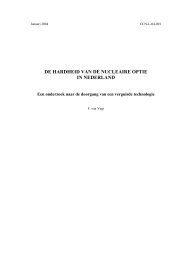


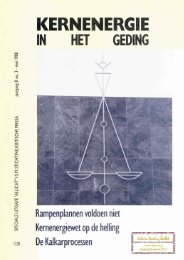
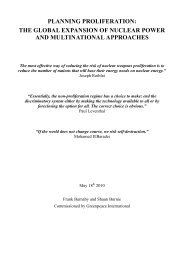
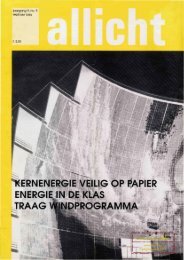

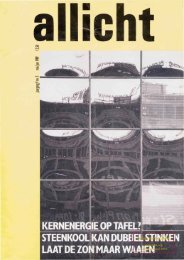
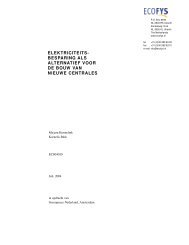

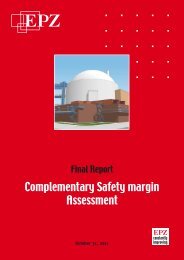

![EPZ jaarverslag 2009 [PDF] - Laka.org](https://img.yumpu.com/40394048/1/190x190/epz-jaarverslag-2009-pdf-lakaorg.jpg?quality=85)
